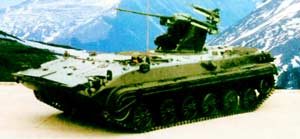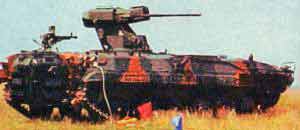| Designation: | MLI-84 |
 |
|---|---|---|
| Manufacturer: | Ratmil Regie Automoma | |
| Product type: | Armoured Vehicles | |
| Name: | Infantry fighting vehicle |
In appearance and layout the Romanian MLI-84 is virtually identical to the Russian Kurgan Machine Construction Plant BMP-1 infantry fighting vehicle, but is slightly larger and heavier and has a 12.7 mm anti-aircraft machine gun mounted over the left side of the rear troop compartment. Description
The MLI-84 is fully amphibious, being propelled in the water by its tracks, and is fitted with an NBC system and night vision equipment for commander, gunner and driver. This vehicle only has three rectangular roof hatches compared with the BMP-1, which has four. In place of the left rear rectangular hatch is a circular hatch cover on which is mounted the 12.7 mm anti-aircraft machine gun.
Prime contractor for the upgrade currently being undertaken is the Mechanical Factory for Armament (MFA). Variants
Following an international competition, the Romanian Army selected the Israeli RAFAEL Overhead Weapon Station 25 mm (OWS-25) to upgrade its MLI-84 vehicles.
Late in 1998 the RAFAEL Armament Development Authority supplied the first batch of Overhead Weapon Station 25 mm (OWS-25) to Romania for installation on the upgraded MLI-84M.
This OWS is armed with an Oerlikon Contraves 25 mm KBA cannon, 7.62 mm PKT machine gun mounted externally on the right side and two Malyutka M2T anti-tank guided weapons (ATGWs) on the left side.
It was expected that these would have been the Maliutka M2T, which includes the Euromissile MILAN 2T tandem HEAT (High-Explosive Anti-Tank) warhead. The RAFAEL Armament Research and Development Authority SPIKE long-range (SPIKE-LR) ATGW will be fitted instead.
A day/night sight is fitted as standard with a thermal sighting system being an option. The day sight has magnifications of ×1 and ×8 while the passive night vision elbow has a magnification of ×7.5, in addition there are also four day observation periscopes. As the weapon is mounted externally it can be aimed and fired with the gunner under complete armour protection.
Turret traverse and weapon elevation are all electric and the main armament is stabilised in both elevation and traverse, manual controls are provided as a back up. Turret traverse is a full 360°, with weapon elevation from -11 to +60°.
A total of 200 (60 armour piercing plus 140 high explosive) rounds of ready use 25 mm ammunition and 200 rounds of ready use 7.62 mm machine gun ammunition are carried.
The 25 mm KBA cannon has four rates of fire, single shot, 100, 200 or 600 rounds per minute with dual belt feed system giving the operator an immediate ammunition selection capability.
Types of 25 mm ammunition fired include armour piercing fin-stabilised discarding sabot tracer, frangible armour-piercing discarding sabot tracer, high explosive incendiary tracer, semi-armour piercing high explosive incendiary tracer and training natures. Reserve ammunition consists of 450 rounds of 25 mm, 2,000 rounds of 7.62 mm machine gun and two ATGW.
A total of six electrically operated 81 mm smoke grenade launchers are fitted, three on either side of the hull and the MLI-84M can also lay its own smoke screen by injecting diesel fuel into the exhaust outlet on the right side of the hull.
While first OWS-25 were supplied direct from Israel the plan is that the MFA will progressively undertake local production of the complete mount over the coming years. The first Oerlikon Contraves dual feed 25 mm KBA cannon were supplied via Italy with progressive licenced production being undertaken in Romania.
The MLI-84 with the weapons upgrade has a combat weight of 17,080 kg and a maximum height of 2.942 m. Other data is similar to the standard MLI-84.
Standard equipment includes an NBC system of the overpressure type and fire detection and suppression system for the engine and crew compartment, which is supplied by EADS S & D L'Hotellier. Harris provides the communications equipment.
Survivability is further enhanced by the installation of a locally developed laser and infra-red warning system called SAILR-M, which is coupled to 81 mm electrically operated smoke grenade launchers. SAILR-M comprises two sensor units and a central processing command and display unit. It is claimed that it can initiate a response within 50 milliseconds of detecting a threat.
It is expected that 180 vehicles will be upgraded to the enhanced MLI-81M standard at a cost of about USD290 million over a five-year period. The first batch of MLI-81M 'Jderul' IFVs became operational with the Romanian Land Forces in July 2005.
Perkins Engines Company of the UK has supplied a CV-8 diesel engine rated at 400 hp for installation by RATMIL, the original builder of the MLI-84, as a replacement for the existing 8V-1240 DT-S supercharged diesel developing 360 hp.
The CV-8 has now gone out of production for military applications although production could start again if further orders are placed.
Perkins Engines Company then offered the Caterpillar C9 rated at 400 hp for the MLI-84. This is lighter engine and has already been adopted for a number of military vehicle applications.
The Perkins Engines Company was subsequently awarded a contract for the supply of 21 Caterpillar C9 engines and a new cooling system.
By mid-2007 Caterpillar Defence Products had received contracts for 130 Caterpillar C9 engines for the Upgraded MLI-84M. Under current plans it is expected that a total of 180 vehicles will be upgraded to the MLI-84M standard.
Each MLI-84M battalion has a total of three companies of MLI-84M each of which has 11 upgraded MLI-84M vehicles.
Each MLI-84M battalion also has a number of specialised vehicles based on a modified MLI-84 chassis. These include one ambulance, one repair and recovery vehicle and two command post vehicles which gives each battalion a total of 37 vehicles.
It is expected that a total of three battalions will be equipped with the MLI-84M with the first unit already fully equipped. This is 280 Infantry Battalion of the 282 Mechanised Brigade.
|
|||||||||||||||
|
||||||||||||
 |
 |
 |
 |
